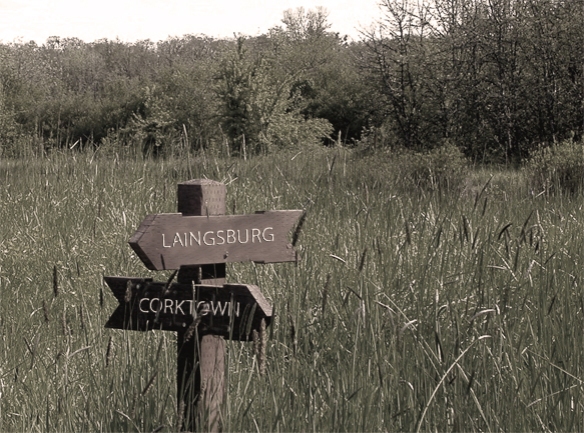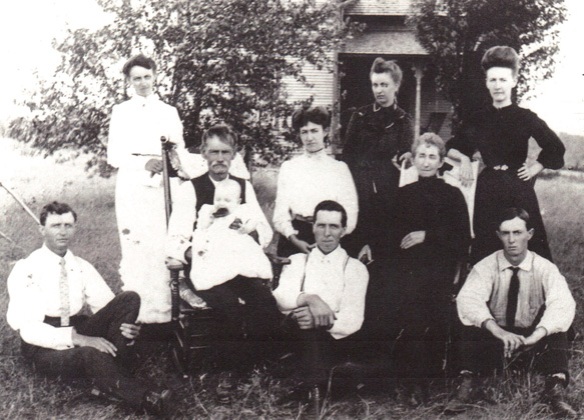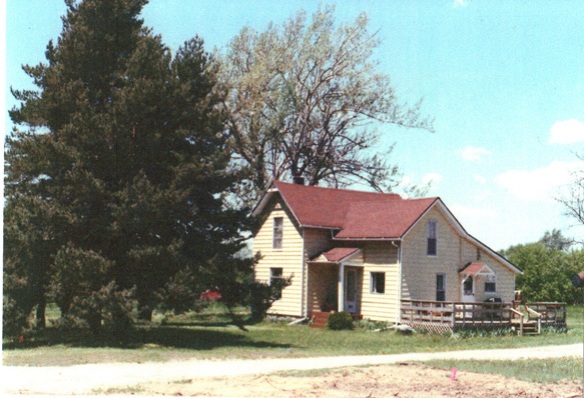
Not everyone can make the prestigious claim of a town bearing their family name. The Amos Boys can. In fact, through their mother’s maternal side, they can actually claim ownership of two towns—two, if you allow a bit of embellishment. And since embellishment is often what family history is all about, we’re going to do just that.
A few miles east of Lansing, near I-69 and Woodbury Road in Shiawassee County, is the has-been Irish community of Corktown. Even though there are Corktowns wherever the Irish have gathered, and even though ours is so small it doesn’t even make the map, we can still puff with a little bród Éireannach.
Corktown was settled by our ancestors, the Corcorans, who came from Roscommon, Ireland in 1838. The Corcorans farmed on Corcoran Road and being the community-minded folk that they were, they donated land for the Corcoran School, the Corcoran Cemetery and a Catholic church.
Looking at our family tree, we find names such as Bartlett Corcoran; who begat Patrick, who immigrated to the United States; who begat Owen; who begat Anastasia. (Anastasia is such a cool name—I really think one of you millennials should name your baby girl Anastasia.)
Now, let’s go seven miles up the road to the small town of Laingsburg. With a population today of 1283, this cozy, little community is actually listed on the map. Laingsburg was settled by our ancestor Peter Laing, who, in 1836, moved to the area from New York and set up a tavern.
From the Laings, we can boast Scottish roots. We have John Laing, who immigrated from Annondale, Scotland in 1773; who begat William; who begat Peter, who founded Laingsburg; who begat Paisley.
Let’s now connect these two families.
In 1870, Paisley Laing and Anastasia Corcoran married. They settled on Stoll Road, south of Laingsburg and raised this great family of five children, one of whom was Maggie Francis Laing, the Amos Boys’ grandmother.

Paisley and Anastasia Laing Family
Standing, l-r: Nellie, Phoebe, Maggie
Middle: Paisley (holding Hazen, baby of John and Fanny Hart), Fanny, and Anastasia
Front: Joseph B. Gulick (Nellie’s husband), John Hart (Fanny’s husband) and Earl Gulick (Maggie’s husband). Missing from the photo is Paisley and Anastasia’s son Peter, who perhaps was the photographer.

Paisley and Anastasia’s farmhouse as it is today, 10060 Stoll Rd., south of Laingsburg.
So here we have a summarized version of our family on the Amos Boys’ mother’s maternal side. In two weeks, we’ll take a further look at Laingsburg and its founder Peter Laing. In the meantime, be sure to read Dave’s comments. He’s a super sleuth and found interesting data on the Laings.
Reunion
What are your plans for the upcoming reunion on June 16? We’ve got great ideas formulating, including a self-guided road trip to Laingsburg, Corktown, Williamston, and all the family farmhouses and cemeteries in between. Let us know so Elaine, Jan, Shelley and Jerri Lynn have an idea of how many are coming. Be there!

This site (http://www.archive.org/stream/genealogicalreco00john/genealogicalreco00john_djvu.txt) contains the genealogical records of the decendants of a Peter Jonhston, who was Dr Peter Laing’s grandfather. The site is a little confusing to follow (especially when the same first names were used over and over again), but it has a interesting description of the Johnston clan in Scotland along with life in New York.
Here are some highlights:
Peter Johnston was born in Lockerby, Annandale, Dumfriesshire, Scotland, in the year 1735. He was married about 1763 to Jane Mundle, who is believed to have been the daughter of Andrew and Betsey Mundle. They settled in Lockerby and there had two children (there might also have been a son Peter):
Elizabeth b. Mar. 22, 1765; d. about 1848; m. Wm. Laing.
Andrew b. Sep. 6, 1769; d. Mar. 4, 1846; m. (i) Susannah
In 1773, Peter Johnson applied for and received a certificate of good character and embarked to America with his wife and children. John Laing and his family, from Langholm, Dumfriesshire, also took passage on the same vessel. The two families settled on adjoining tracts in Palmerston, Saratoga Co., N. Y. where they engaged in farming and cutting timber.
Around 1785, Elizabeth Johnson married William Laing, son of John and Helen Laing. Consumption, prevalent in Saratoga Co. in those days, killed five of their children. Their many other childer included:
Peter b. June 25, 1788; d. Apr. 14, 1865; m. (1) Mary Calkins, (2) Mrs. Laura Kemp.
Peter Laing studied medicine as a young man and became a practitioner in his native town. On Nov. 17, 1810, he was married to Mary Calkins, who was born in Saratoga Co. in 1791. In 1833, they joined the army of pioneers then moving into Michigan, and settled at Ann Arbor, where Peter practiced his profession for three years.
After his wife died, Peter set out with his son William and his son-in-law Mason Phelps, and on Sept. 24,1836 they took up claims in Sciota Township, Shiawassee Co., Mich., on the Grand River road. With the exception of Samuel Carpenter, who was accidentally killed shortly after he settled there, these three men were the first to locate in this vicinity. Peter erected a log cabin with the goal of opening a tavern. This tavern, the first building erected in Sciota, was a mere shanty of logs, with no floor but the bare ground, and no chimney except a hole in the roof; the fireplace was made of loose stones piled up in one corner. But despite its rudeness this tavern soon became a famous landmark and one of the most popular roadside resorts in this section of the State. In 1837 Peter had a post office established in the tavern, and at his request it was called Laingsburg.
Sounds like Peter Laing’s parents came over from Scotland. A website on Laingsburg, MI said “Laingsburg was founded by Dr. Peter Laing in 1836. His parents came from Scotland, he was born in New York in 1788, married in 1810, moved to Ann Arbor in 1833 and practiced medicine, and came to this area which would become Laingsburg in 1836. At the corner of Fenner and Grand River roads he built Laing Tavern.”
Maybe we could stop in at the tavern for a half-pint (or a pint) of ale!
Very interesting! I’m excited to take the tour.
Ah-ha!! So we really do have a legitimate claim for frolicking on St Patty’s Day! And all these years I’ve been wearing orange…
Yes, and this must be why I’ve always thought bagpipes are cool. I’m thinking we should get a piper band for the reunion and all the men should wear kilts. Does anyone know our family’s plaid?
I found this for starters: http://www.tartanregister.gov.uk/tartanDetails.aspx?ref=2027
Great! I’ll ask our Scotish professor where he gets his kilts made, LOL!
Dave…….. Just a little addition: John Laing’s wife’s complete name was Helen Nellie Paisley Laing. You may already have this information. Having two daughters, I am always wondering who a married woman really is when her family name is missing. A more complete name also might help to see where a first or middle name came from. It looks like Dr. Peter Laing had three children with “Paisley” in their names: William Paisley b.1813, Nellie Paisley b.1824, and Paisley Francis Laing b.1848.
Uncle Jerry, your comments regarding women and their family names are interesting. I wonder if today’s practice of women keeping their maiden names will make genealogy research easier or harder?
Also, my daughter-in-law is Chilean, and their practice is to have two last names – the mother’s last name first, and the father’s second, with the father’s being primary. It seems this would make genealogy much, much easier.
Pingback: Get Those Cars Tuned, We’re Doing a Road Trip | Those (Expletive) Amos Boys
Pingback: Finding Culture Within the Family | Those (Expletive) Amos Boys
Hello! For years I lived right across the street on the corner of Fenner and grand river, from where “blood tavern” was in the past.
not sure how you feel about ghost stories but our property and surrounding area always has am eerie feel and the darkness in this area of the night was darker than I ever experienced ever. My grandma Carol Hart told me stories of the area and even gave me an Christmas decoration with a painting of the tavern on it.
Jessica, how fun (or not:-). Thanks for sharing!
I am a LAING researcher. Would like to contact your genealogical researcher.